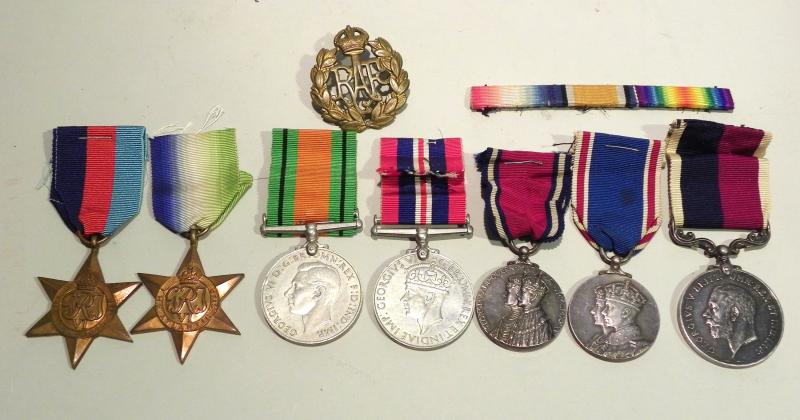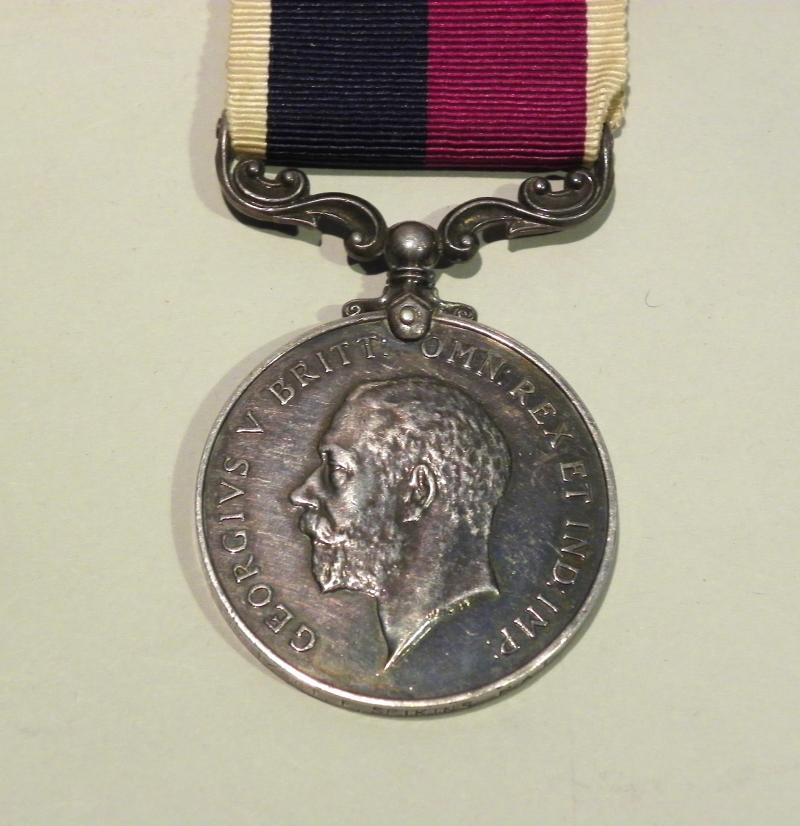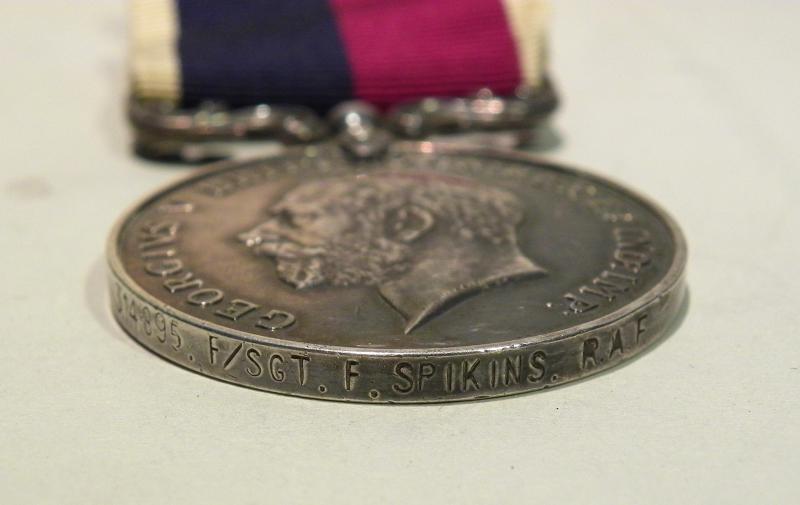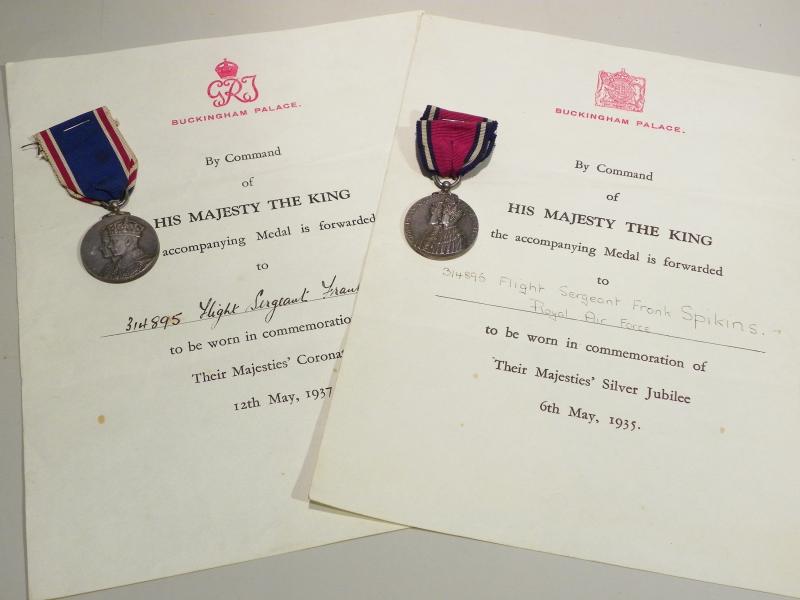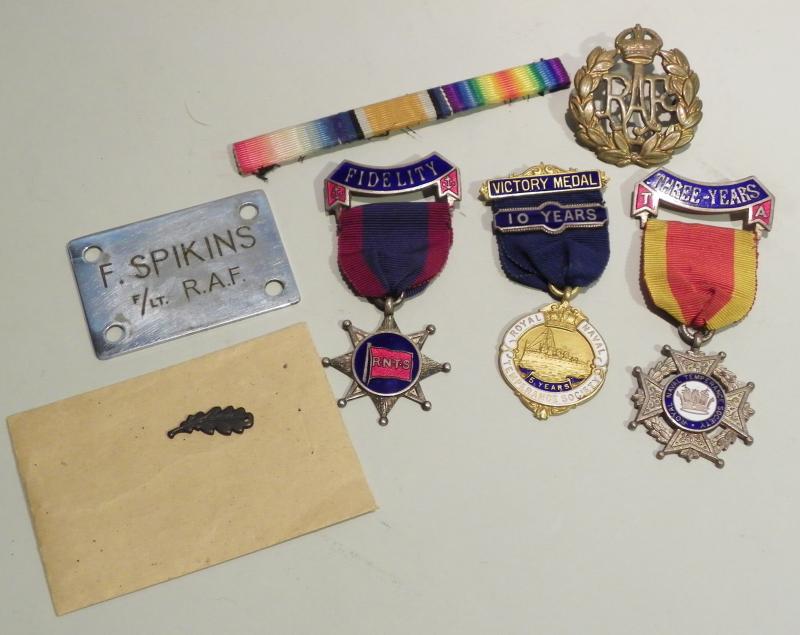A superb WW2 Group to Flt Lieut Spikins MID RAF. Killed 1941
Firstly, let me describe what this lot comprises of, first the medals; 1939/45 star, Atlantic star, Defence medal, 1939/45 war medal, George V Jubilee medal, George VI Coronation medal, the Royal Air Force LS&GC medal correctly named to 314895 Flight Sergeant F Spikins R.A.F. Three Royal Navy temperance society medals and MID oak leaf in original packet. RAF Identification plate and WW1 Medal Bar, he is also entitled to a 1914 star Trio, more about that below
Also various original paperwork including Warrant Certificate, Commission Certificate, award certificate for both the Jubilee and Coronation medals, RAF training Pilots log book, training exercise book, photographs, Memorial Certificate and Kings letter slip, Runnymede memorial register booklet, given to next of kin. Medal issue slip, condolence type. As well as all of this original paperwork, included is also various copied paperwork and research, medal roll, service papers, London gazette entries, census details, Commonwealth war graves certificate, RAF muster rolls etc.
Frank Spikins was bone in Hammersmith London around 1896. He trained as an engineer fitter, taking after his father George.
In 1913 Frank decided to join the Royal Navy Reserve as a Boy II and by the time war broke out in just over a year later, Frank was serving on board HMS Exmouth.
HMS Exmouth was a Duncan-class pre-dreadnought battleship of the Royal Navy, during WW1 she was with the 3rd Battle Squadron of the Grand Fleet, to patrol the English Channel and cover the movement of the British Expeditionary Force to France. She also saw service at Scapa Flow, Exmouth worked with the Grand Fleet's cruisers on the Northern Patrol and later transferred to Sheerness on 30th December 1914 to relieve the 5th Battle Squadron there in guarding against a German invasion of the United Kingdom.
On the 12th May 1915 she left for service in the Dardanelles Campaign; in June, Exmouth, the battleship Swiftsure, and the protected cruiser Talbot went to Cape Helles to support an Allied attack on the Turkish-held heights at Achi Baba, Frank still serving on board.
After the Dardanelles in November 1915 she transferred to the Aegean Sea to become Flagship, 3rd Detached Squadron, a force based at Salonika that had been organized to assist the French Navy in blockading the Aegean coast of Greece and Bulgaria and to reinforce the Suez Canal Patrol. She then took part in the pro-Allied coup against the monarchy in the Noemvriana, which the Allies sought to support. Exmouth participated in the seizure of the Greek fleet at Salamis and landed Royal Marines at Athens on 1st December 1916.
When HMS Exmouth transferred to the East Indies Station in March 1917, Frank left the ship and transferred to the Vivid I, at this point a Signalling and Telegraphy School in Devonport and then to HMS Defiance the Royal Navy's torpedo school, now at the Rating of Able seaman.
On the 2nd February 1918 he is seen aboard HMS President; whether it was the shore establishment of the Royal Naval Reserve, based on the northern bank of the River Thames near Tower Bridge or the newly built anti-Submarine ship, is unknown, but he applied for an was granted a place in the newly formed RAF in March 1918. For his service in the Royal Navy and Royal Naval reserve he was awarded the 1914 Star, British war and Victory medal. This trio of medals are missing, probably because they would have been mounted for wearing and his later group wasn’t awarded until after he had died.
It appears that Frank made the RAF his sole career, steadily rising in rank through the years in the Technical Engineer department, to Warrant officer in 1938, to a commissioned officer of Flying Officer and finally Flight Lieutenant in 1941 and he was mentioned in dispatches that same year. He became an Auto pilot expert and became flight crew as flight lieutenant / engineer. He took part in many flights, his logbook is full, and it seems to me he was an on-board engineer testing aircraft after repair particularly auto pilot systems, navigational instruments and torpedo operation, also he may have also been training pilots to use this equipment. He was also serving on resonance missions in the North Atlantic, spotting U-boats. But this is a very limited description of his many duties. He probably served with more than one squadron in his 23 years with the RAF, but towards that latter part he was serving with 612 squadron.
This Squadron was formed at Dyce on 1 June 1937 as an army co-operation unit of the Auxiliary Air Force. At the end of the year, it received Hectors, but on 1 November 1938 it was redesignated a general reconnaissance squadron, receiving Ansons in July 1939. Hectors were retained until November, but the Ansons began coastal patrols on the outbreak of World War Two. In November 1940, conversion to Whitley’s began and these flew their first patrols in February 1941, though it was the end of the year before the last Anson left. In December 1941, 612 Sqn moved to Iceland. It was on a transfer flight on 25th December 1941 that the Whitley Z6810 went down over the sea.
Pilot Officer J F Catchpole, Pilot Officer P J Halliday, Sergeant J H Taylor, Sergeant W Jamison, Sergeant W H Lamond, Sergeant J Wilson, Flying Officer E C Scholefield, Flying Officer J Fiddes and Flight Lieutenant F Spikins were reported missing believed killed.
The entire aircraft and crew were missing and never found, Frank Spikins and his crew members are now remembered with honour at Runnymede Memorial. The son of George Thomas and Elizabeth Spikins and Husband of Ella Spikins of Acton Middlesex.
Frank Spikins had three different service numbers during the time he served, J.22908 with the Navy, 314895 RAF first number and 43569 RAF second number. All confirmed in accompanying paperwork.
I think Frank was an incredible man obviously a very talented engineer, I often wonder what men such as Frank could have achieved had they survived and what great things they could have contributed to the world.
All medals and paperwork are in very good used condition you get everything you see in the pictures, too much to list every item.
Code: 29610
520.00 GBP


